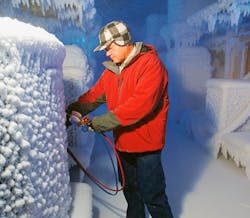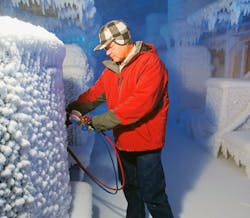Trane Completes Phase 1 of Cold Climate Heat Pump Challenge
Trane announced on November 2 that its engineers had successfully completed the lab testing phase required for the Biden Administration's Cold Climate Heat Pump Challenge.
The Administration believes that rapidly increasing U.S. manufacturing's output and deployment of electric heat pumps is critical to achieving U.S. climate, energy savings and energy security goals.
Basically, it wants to know that heat pumps will be a viable solution. Therefore, input received by HVAC system manufacturers will guide the Department of Energy's decisions to maximize the $250 million Defense Production Act investment in heat pumps, funded through President Biden’s Inflation Reduction Act, to reduce the nation’s reliance on fossil fuels, strengthen national defense and energy security, lower consumer energy costs, improve home efficiency, and mitigate the climate crisis. Sources say heat pumps offer an energy-efficient alternative to furnaces and air conditioners for all climates by using electricity to transfer heat from a cool space to a warm space, making the cool space cooler and the warm space warmer. Because heat pumps transfer heat rather than generate heat, this technology efficiently provides comfortable temperatures for heating and cooling homes and businesses.
We provided questions about the CCHP Challenge to Katie Davis, vice president of engineering and technology, Residential HVAC, Trane Technologies.
Contracting Business: Katie, please encapsulate how heat pump technology has advanced for use in cold climates.
Katie Davis: Colder ambient temperatures require changes to the vapor compression cycle utilized in a heat pump to provide the heating capacity required at 5 degrees F and below. Compression technology has now advanced to the point where we can incorporate this capability into the system and provide the additional capacity required.
Trane continues to provide the most efficient options available today including heat pumps, more environmentally minded furnaces, and the pairing of the two in dualA heat pump is effective on its own at all temperatures, because of its ability to use a gas furnace or an air handler with supplemental electric heat when temperatures drop to help heat a home.
Currently, primary markets include areas in Florida, South Texas, New Mexico, Arizona, Seattle and Portland, while some secondary markets include parts of Georgia, South Carolina, North Carolina and the Northeast.
You can install a heat pump even if you have a furnace and live in a colder area. When it’s cold outside, a heat pump extracts what outside heat is available and transfers it inside. When it’s warm outside, it reverses direction and acts like an air conditioner, removing heat from the home.
A heat pump is effective on its own at all temperatures, because of its ability to use a gas furnace or an air handler with supplemental electric heat when temperatures drop to help heat a home.
The most efficient heat pumps, like the Trane Platinum XV20i, can operate in temperatures as low as 0 degrees Fahrenheit.
There are no products in the market that currently meet the DOE CCHP Challenge performance specifications.
The table below details the performance requirements to meet these specifications. In summary, a heat pump of 4-tons and lower must have a COP of 2.4 while providing 100% of nominal rated capacity at an ambient temperature of 5F. A heat pump larger than 4- tons must have a COP of 2.1 with the same nominal capacity requirement at 5F. In addition, the heat pump must have an HSPF2 = 8.5 in Climate Zone 5.
CB: What performance standards are required for the heat pumps?
KD: In summary, a heat pump 4-tons and lower must have a COP of 2.4 while providing 100% of nominal rated capacity at an ambient temperature of 5F. A heat pump larger than 4 tons must have a COP of 2.1 with the same nominal capacity requirement at 5F. In addition, the heat pump must have an HSPF2 = 8.5 in Climate Zone 5. These are the parameters that were met as part of the testing. Heating is expressed in HSPF (Heating Seasonal Performance Factor) instead of AFUE which is used for furnaces.
'Following a successful regional launch in spring 2022, the full line of Trane Link equipment will be available to Trane’s independent dealers nationwide beginning in November 2022.' - Katie Davis
Passing the lab testing phase means we’re now able to conduct field testing with this heat pump, which will provide us with the opportunity to keep a family warm this winter. What’s more, is that getting to this phase in the challenge ultimately brings us one step closer to seeing through the commercialization of our CCHP to better meet the heating needs of homeowners today and boldly challenge what’s possible for a more sustainable world in the future.
CB: What simulations were necessary to meet the challenge?
KD: When tested at the DOE’s lab, the Oak Ridge National Lab Facility, Trane’s CCHP prototype performed in temperatures as low as negative 23 degrees Fahrenheit, surpassing the mandatory negative 20 degrees Fahrenheit DOE requirement. Our prototype pushed the limits of the testing with high performance even as temperatures moved beyond the trial scope. To stop our Trane unit, they had to manually cut the power.
CB: How long have Trane’s engineers been at work on this testing and development?
KD:At Trane, sustainability is foundational to who we are. In 2018, prior to the Cold Climate Heat Pump Challenge announcement, we were already committed to addressing decarbonization. We were actively assessing different technologies that would directly enable us to create heat pump solutions that work in spaces where fossil fuel burning furnaces were typically installed. By evaluating how we could improve efficiencies with our heating products, in 2020 we dedicated an entireCB: Describe the conditions for the upcoming trials in Boise.
KD: Our high-efficiency, cold climate heat pump will begin field trials this November. The prototype will be placed in cold climate ambient operating conditions in a residential building. A successful field test is performance during the heating season in extremely cold conditions, delivering energy-efficient heating capacity to meet the building load. Simply stated, providing energy efficient heating in extremely cold temperatures in a residential application.
CB: When might the heat pumps be ready for shipment to dealers?
KD: DOE may decide to extend the field trial testing into a second heating season. If this is the case, we will participate in the second field trial in 2023. If field trial testing concludes in 2022, we will continue toward commercialization of the product.
CB: Will Trane be scaling back its production of traditional gas-fired products?
KD: We keep customers at the heart of all we do by meeting the needs of the market to provide efficient, comfortable environments. We will continue to provide the most efficient options available including heat pumps, more environmentally friendly and efficient furnaces, and the pairing of the two in dual fuel systems.
'We don’t plan on scaling back until the marketplace demands it, and we have the replacement products to meet the same need. The goal is to meet the needs of the customer in the most efficient, environmentally friendly manner.' - Katie Davis
We don’t plan on scaling back until the marketplace demands it, and we have the replacement products to meet the same need. The goal is to meet the needs of the customer in the most efficient, environmentally friendly manner. Until the latest prototype is available for purchase, the company will continue to provide the most efficient options available today including heat pumps, more environmentally minded furnaces, and the pairing of the two in dual fuel systems.
The Inflation Reduction Act includes a substantial expansion of the Energy Efficiency Home Improvement Tax Credit (25C) as well as an extension and expansion to the New Energy Efficient Home Tax Credit (45L). To be sure to make the most of the credits and rebates offered through the IRA, we recommend homeowners reach out to their local HVAC professional, like a Trane Comfort Specialist.
Our Trane Platinum XV20i heat pump is part of a new line of equipment featuring Trane Link, a revolutionary communication technology, designed to simplify installation, commissioning, and remote monitoring of our variable speed HVAC systems.



